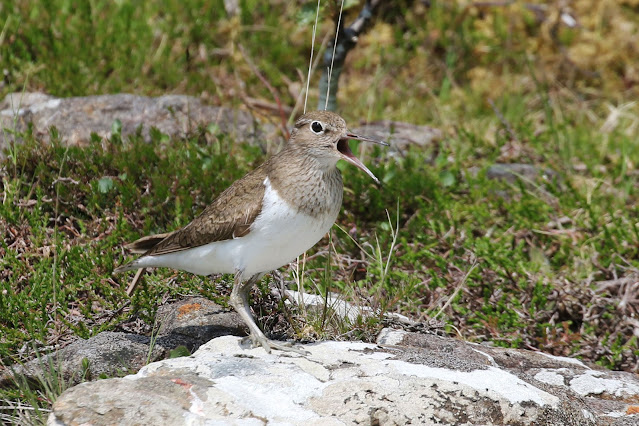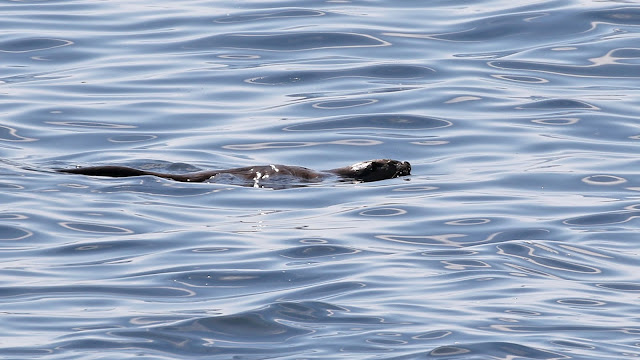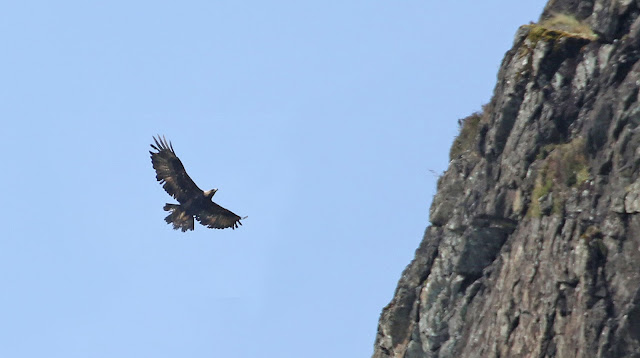Another glorious day, the only area of the island we had left to explore was the south west corner, so after filling up with fuel in Craignure we headed along the Glen More road before turning off to go up and over a ridge that led down to the shore line of Loch Spelve. A beautiful road runs alongside the shoreline while on the other side it was dominated by purple flowering rhododendrons. Loch Spleve is like a whale's tail as the sea comes in through a narrow channel then opens up to stretch east to west. We then travel up and over a small ridge to a freshwater loch, Loch Uisg that feeds by a river into our destination Loch Buie, considered to be one of the beautiful spots on Mull.
Back in 2008 we had visited here in rain and heavy overcast conditions and it looked pretty much like anywhere else, this morning though in the warm sunshine it was at its best. From the car park we set off to walk the southern shore line on a path that ultimately reaches Carsaig.
The start of the walk passes cliffs that were clearly shaped and eroded by the sea. Calls of Common Sandpiper could be heard from the rocks and beach, but as we turned a call one came from the land side of the path and the owner was perched on a rock and allowed me to get very close.
There was a track that was easily walk-able, while on the land side the ground was damp and marshy, not ideal conditions for plants and I wasn't surprised to see several Sundews, carnivorous plants that rely on catching insects for their nutrients.
As well as the Common Sandpipers calls there were also several Rock Pipits to be seen amongst the boulders and rocks on the beach.
In amongst the cliffs were many caves, some of which were occupied by cattle looking to cool off from a warmth that was now cranking up.
After about two miles we came across a group of disused farm buildings. Signs around the old property referred to leaving the buildings to be reclaimed by the resident wildlife.
Beyond the farm buildings was a stream that was quite wide but full of boulders and rocks that allowed you to be able to easily cross. White markings on some of the rocks indicated the possible presence of Dipper but I was not able to see any.
Swallows swooped low over the meadows and appeared to be nesting in the disused farm buildings.
The path after the stream started to fade out and it became a lot more rocky and in places muddy and marshy. Looking ahead the way forward looked quite challenging so we decided that a combination of a difficult walk and the heat of the day was not a good thing so we turned around and headed back along the good path.
Here some views showing the beauty of the surroundings and the day.
The women headed off quickly keen to get back for ice cream. As I walked along I scanned the beach and sea and stopped when I saw something move on the water. I waited and eventually a head broke the water and dived again showing a long snake like tail, an Otter. We waited to see where it would come up again. It didn't take long and it came up again, this time swimming towards the beach.
We waited, I even climbed down to get a better look through the rocks but couldn't see any sign of it. The Otter was probably curled up somewhere under a rock or drying off in the sunshine.
Realising it was not going to show we decided to walk on, it was very hot now. Looking out across the loch a Red-throated Diver came up off the water and flew away from me. This completed the set of divers for the visit.
After lunch we decided to walk around the west shore of the loch. The rhododendrons in bloom looked spectacular around the sandy bluff that leads out into the loch.
The island itself was like a huge sponge with plenty of moss and damp marsh. We were clearly too close to the Oystercatchers as a pair were continually calling and as we walked away.
We made our way across the sandy beach using the footsteps we had made before, then headed towards the Moy Castle, the ruin of which is alongside Lochbuie House.
We left Loch Buie in agreement that it was a lovely spot, the weather playing its part in a lovely location. Reaching the Glen More road we turned left and headed down to the Golden Eagle nest. Fortunately there was a parking space available and getting out of the car I watched one of the adults flying up to the nest entrance.
A fantastic show once again from these eagles, showing off the size and majesty of these incredible birds of prey. The Isle of Mull has the highest density of this magnificent eagle in Europe and this makes this the best place to see them. The best time is said to be from now into the autumn when the young take to the air.
The two days we have had with them have been the best views of Golden Eagle we have had, it has truly been impressive.
We left the eagles and headed down to Loch Scridain in the hope that we could catch up with the Otter we had seen earlier in the week. Unfortunately the only views we had was of the rocks and sea weed, no Otters today
That was it for the day and we headed back through Glen More, hoping for something along the way, but only managing a White-tailed Eagle over Loch Don.
In the moth trap over night a few more different species, including te first hawk moth of the year.
A Poplar Hawkmoth.










































































No comments:
Post a Comment